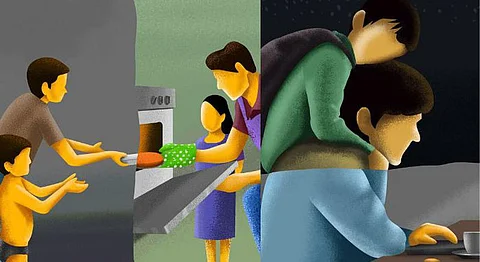
- HOMEGROWN WORLD
- #HGCREATORS
- #HGEXPLORE
- #HGVOICES
- #HGSHOP
- CAREERS
- ABOUT US
- CONTACT US

“I don’t know...
I don’t know, how foolish they are to sleep on the railway track...
I don’t know, why can’t they wait...
I don’t know, why do they want to go home...
I don’t know, why would they walk...
I don’t know.... yeah! you don’t know, you would never know.”
This is the caption of an artwork illustrated by Akhil Monu Mathew, an illustrator and creative director from Bangalore, depicting the humanitarian crisis that has been deemed by renowned historian, Ramchandra Guha as the ‘greatest manmade tragedy’ in India since the Partition.
Lakhs of migrant workers from rural areas were driven out of work as establishments in urban areas shut down overnight due to the countrywide lockdown on 24 March, midnight. The lockdown in the wake of the COVID-19 crisis was imposed without prior notice, leaving people stationed outside their home-towns at a loss as to how to get back home. All modes of transportation, including trains, buses, and flights were halted due to the lockdown.
Not a thought was spared for those who didn’t have a roof to call their own. Night shelters run by local authorities began overflowing with homeless and jobless migrant workers, and supplies started dwindling. These workers, most of whom had come from their villages in Bihar, Uttar Pradesh, Odisha, and Jharkhand to make a living in big cities, were left with no choice but to head home on foot. However, with inter-state borders blocked, they were stranded in the middle. For those who made it, it wasn’t a pleasant welcome. They were dealt with an iron hand by police forces and security personnel for no fault of theirs.
However, the impoverished and the underprivileged being treated as dispensible in these circumstances is merely an extension of the rich-poor dynamics in India in general. Deep inside, we all knew it wasn’t unprecedented. It is time we, as a nation, did something about it.
In an interview with Homegrown, Debjyoti Saha, another artist based out of Mumbai, mopes that, “In a population of 1.3 billion, some voices are heard more than others… I’m glad that the government is going out of its way to do something for Indian nationals stuck in a foreign land. I realize this after seeing the state of foreigners in our country stuck during the pandemic. But it is upsetting to see another group of Indians stranded in their own country without food, shelter and unable to reach their homes. It is quite complicated and deeply saddening.”
As part of an ongoing personal series, Korona, that Debjyoti has been working on during this quarantine, he has created an animated video showcasing a stark contrast between lives of privileged citizens with those of the plight of the migrant workers. This was a deliberate effort on his part to highlight the migrant crisis, which he felt, akin to all news in contemporary times, is in danger of being erased in a flurry of new events and articles. “Public memory is short.”, he bemoans. “This news will soon fade away, but I hope the message stays.”
However, he believes that “Animation storytelling has the power to do what might not be achievable in any other medium.”
“The complex relation between you and the animated piece, where you know what you’re watching is not “real” yet speaks to you about “reality”, is perhaps its greatest strength.”
You can check out Akhil Monu Mathew’s artworks here.
You can check out Debjyoti Saha’a artworks here.
If you enjoyed reading this article, we suggest you also read:
